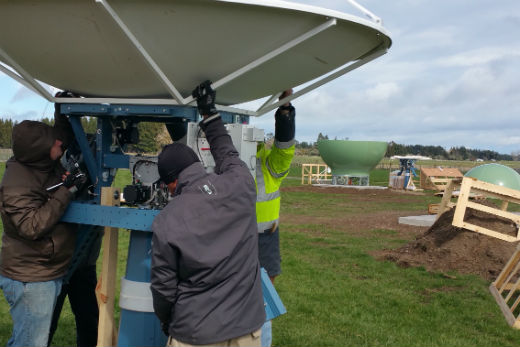Construction has been completed on a satellite ground station south of Rotorua that will significantly boost capability in New Zealand and Australia's search and rescue regions.
The facility can cover north to the Equator, south to the South Pole, east to half way across the Pacific and west half way across the Indian Ocean.
Technicians installing a dish at the new MEOSAR ground station. Photo: Supplied.
The receiving station, east of Broadlands, was built as part of a joint project by Maritime NZ and the Australian Maritime Safety Authority.
'This is truly a joint system for New Zealand and Australia,” says Maritime NZ Director Keith Manch.
'Our two countries are responsible for a huge section of the earth when it comes to search and rescue, and without our joint contribution there would be a significant gap in the network.
'Beacons can take the ‘search' out of search and rescue, and the system will dramatically increase the global SAR capability.
'Emergency distress beacons are key equipment for anyone operating at sea, on land and in the air – whether commercially or recreationally – but they can't operate without sites like this.”
Existing beacons, of which there are 54,000 registered in New Zealand, will not be affected by the change in satellite systems.
The Bay of Plenty site, together with a similar receiving station in Western Australia, is constructed ahead of the introduction of a new generation of medium-Earth orbit search and rescue satellites, which will begin operation in 2017.
The new satellites, orbiting at around 20,000 km above Earth, are replacing the current low-Earth orbit satellites orbiting at between 800-1000 km, which are being phased out over the next four years.
The New Zealand contract, managed by Maritime NZ, is made up of $7.2m for construction of the receiving station and $5.5m in operating costs over the next 11 years.
The two sites will undergo rigorous testing before the system is officially brought online in late 2017 by the international coordinating body for global search and rescue.
The six satellite dishes at the new site are covered by domes to protect them from the weather and are designed to be as visually unobtrusive as possible. The receiving station is expected to be officially commissioned towards the end of 2016.



0 comments
Leave a Comment
You must be logged in to make a comment.